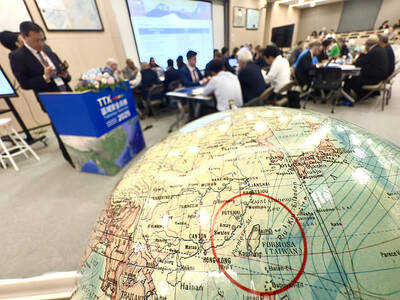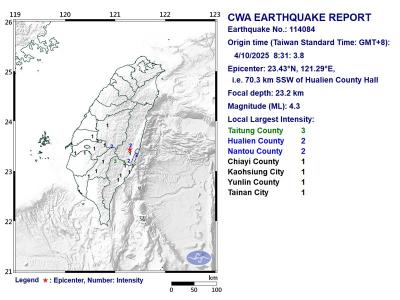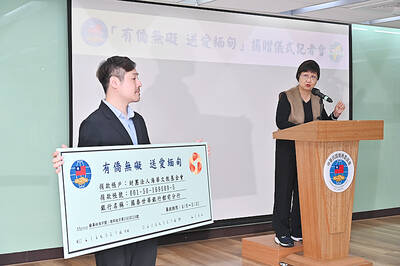Premier Wu Den-yih (吳敦義) yesterday said he considered it unnecessary to insist that people write the first of the two Chinese characters for “Taiwan” in full traditional form (臺), as the simplified form (台) requires fewer strokes and is used by more people.
Some people prefer the character written in traditional form, while others favor writing it using the simplified form, Wu said, adding that he “respected people’s right to choose.”
“As long as people who write the character do so properly and those who read it know what it is, each form is fine. [Writing using the variant character] has been established by [customary] usage,” Wu said.
Wu made the remarks while commenting on a recent policy by the Ministry of Education to replace the simplified form of the character printed in the ministry’s literature and textbooks with the traditional form, a goal the ministry said it hoped to accomplish by the end of next year.
The ministry said students who wrote the character using the simplified form in national exams or entrance exams would not have grades deducted.
“Writing the character in traditional form is not compulsory, even in school exams,” said Chen Hsueh-yu (陳雪玉), executive secretary of at the ministry’s National Languages Committee. “What we seek to accomplish, however, is to encourage institutions and schools under the ministry to use the character written in its traditional form.”
After the ministry studied the origin of the character, it decided that the tai in the name Taiwan should be written in traditional form rather than its simplified counterpart, Chen said.
“It’s not that people who are used to writing Taiwan using the simplified form for the first character are wrong per se, but from an educational standpoint, we advocate traditional characters and are duty bound to make that clearly understood by teachers and students,” Chen said.
Earlier this year, the ministry reaffirmed its commitment to teaching traditional characters in the nation’s classrooms after a parent complained that his child had been assigned the study of simplified characters for homework.
The ministry’s Department of Elementary Education said at the time that promoting traditional Chinese characters in school had always been — and remained — the ministry’s policy.
“Traditional Chinese characters are important cultural assets. Their significance as documented in historical documents is unquestionable,” the department said.
“Traditional Chinese characters should be adopted in school, in textbooks and teaching assignments since their promotion is a national policy,” it said.
President Ma Ying-jeou (馬英九) sparked controversy last year when he said that Taiwan and China should come to an agreement on the use of Chinese characters, prompting angry responses from both sides of the political spectrum.
The People’s Republic of China introduced the simplified form of Chinese characters in the 1950s and 1960s to help combat illiteracy in the country.
ADDITIONAL REPORTING BY STAFF WRITER

DEFENSE: The National Security Bureau promised to expand communication and intelligence cooperation with global partners and enhance its strategic analytical skills China has not only increased military exercises and “gray zone” tactics against Taiwan this year, but also continues to recruit military personnel for espionage, the National Security Bureau (NSB) said yesterday in a report to the Legislative Yuan. The bureau submitted the report ahead of NSB Director-General Tsai Ming-yen’s (蔡明彥) appearance before the Foreign and National Defense Committee today. Last year, the Chinese People’s Liberation Army (PLA) conducted “Joint Sword-2024A and B” military exercises targeting Taiwan and carried out 40 combat readiness patrols, the bureau said. In addition, Chinese military aircraft entered Taiwan’s airspace 3,070 times last year, up about

Taiwan is stepping up plans to create self-sufficient supply chains for combat drones and increase foreign orders from the US to counter China’s numerical superiority, a defense official said on Saturday. Commenting on condition of anonymity, the official said the nation’s armed forces are in agreement with US Admiral Samuel Paparo’s assessment that Taiwan’s military must be prepared to turn the nation’s waters into a “hellscape” for the Chinese People’s Liberation Army (PLA). Paparo, the commander of the US Indo-Pacific Command, reiterated the concept during a Congressional hearing in Washington on Wednesday. He first coined the term in a security conference last

A magnitude 4.3 earthquake struck eastern Taiwan's Hualien County at 8:31am today, according to the Central Weather Administration (CWA). The epicenter of the temblor was located in Hualien County, about 70.3 kilometers south southwest of Hualien County Hall, at a depth of 23.2km, according to the administration. There were no immediate reports of damage resulting from the quake. The earthquake's intensity, which gauges the actual effect of a temblor, was highest in Taitung County, where it measured 3 on Taiwan's 7-tier intensity scale. The quake also measured an intensity of 2 in Hualien and Nantou counties, the CWA said.

The Overseas Community Affairs Council (OCAC) yesterday announced a fundraising campaign to support survivors of the magnitude 7.7 earthquake that struck Myanmar on March 28, with two prayer events scheduled in Taipei and Taichung later this week. “While initial rescue operations have concluded [in Myanmar], many survivors are now facing increasingly difficult living conditions,” OCAC Minister Hsu Chia-ching (徐佳青) told a news conference in Taipei. The fundraising campaign, which runs through May 31, is focused on supporting the reconstruction of damaged overseas compatriot schools, assisting students from Myanmar in Taiwan, and providing essential items, such as drinking water, food and medical supplies,